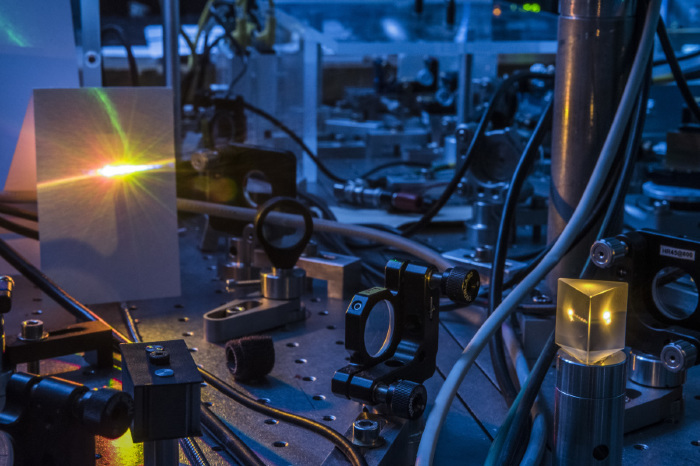Overview
Our group, the multimode quantum optics group of Laboratoire Kastler Brossel, pioneered many aspects of continuous variable (CV) approach to quantum optics. Our main objects of interest are therefore the quadratures of the electric field, which are typically measured through homodyne detection. Our activities generally span both spatial and spectral modes, which we manipulate to develop tools for quantum computation, communication, and metrology.
Our general objective is the creation of multimode squeezed states of optical pulses, either by a synchronously pumped optical parametric oscillator (SPOPO) [1]., or through nonlinear waveguides. As such, our sources can create big entangled Gaussian states, which can be probed in arbitrary modes by shaping the local oscillator of the homodyne detector. In recent years, we have gradually explored mode-selective photon subtraction and addition, which allows us to generate multimode non-Gaussian states of light in a highly versatile way [2].
The group has a strong experimental focus, but also has purely theoretical activities where the framework of CV quantum optics is further developed. In particular for non-Gaussian quantum states, there are still many fundamental questions that remain unanswered [3]. The interplay between theoretical work and experiments is a key element of our group.
Project
In the proposed post-doctoral project, you will work primarily on the SPOPO experiment where you will manipulate the spectral modes of a frequency comb to engineer entangled Gaussian states, and use photon-subtraction to induce non-Gaussian features in these states. Your primary goal is to develop new measurement techniques to extract more information from these intricate quantum states.
On the one hand, you will optimize a multi-pixel setup, which will allow for frequency-resolved multimode homodyne detection. On the other hand, you will implement a double homodyne detection scheme (also referred to as heterodyne detection in some literature), to implement a projective measurement on coherent states.
You will then use these new detection schemes to perform multi-parameter estimation, an important subject in quantum metrology. Furthermore, you will get the chance to work in a collaboration with the neighbouring computer science laboratory (LIP6) to experimentally implement new verification protocols for quantum computation [4].
Gradually, more and more non-Gaussian elements will be added to the experimental setup. On the level of state engineering, you will have the possibility to work on the subtraction or addition of multiple photons. On the detection stage of the experiment, you can incorporate photon-number detection schemes, and test a new type of mesoscopic detector. All of these elements can be used to experimentally explore non-Gaussian quantum steering and to perform ultra-sensitive parameter estimation. Our ultimate goal is then to experimentally establish a relation between parameter estimation and quantum steering [5].
Environment
As a whole, the group has a tradition of working together with a diverse range of people from very varied backgrounds. This diversity often leads to fruitful scientific input from different points of view, and it allows the group to explore new avenues. This has, for example, led to a growing activity in theoretical work over the past few years. The strength of our group is the constructive interplay between all these different points of view. Furthermore, the moderate size of our group gives PhD students and postdocs the opportunity to discuss with PIs on a daily basis. This gives rise to a dynamical atmosphere with a lot of space for discussion.
In your day to day activities, you will supervise PhD students who work on the same experimental setup, and you are responsible for the everyday organisation of the experimental work. You will be involved in the European FET Open project “STORMYTUNE”, which will enlarge your scientific network and provide opportunities for international collaborations.
Practical information
- Application process: Send CV and motivation letter to nicolas.treps@upmc.fr
- Application deadline: Preferentially apply before November 1st (late application will be considered as long as the position has not been filled).
- Salary: Monthly net salary between 2100€ and 2800€, depending on experience
- Starting date: flexible
References
[1] J. Roslund, R. M. De Araujo, S. Jiang, and C. Fabre, Nature Photonics 8, 109 (2014)
[2] Y.-S. Ra, A. Dufour, M. Walschaers, C. Jacquard, T. Michel, C. Fabre, and N. Treps, Nature Physics 11, 1 (2019).
[3] M. Walschaers, C. Fabre, V. Parigi, and N. Treps, Phys Rev Lett 119, 183601 (2017).
[4] U. Chabaud, D. Markham, and F. Grosshans. Phys Rev Lett 124 063605 (2020).
[5] B. Yadin, M. Fadel and M. Gessner, arXiv:2099.08440 (2020).


Recent Comments